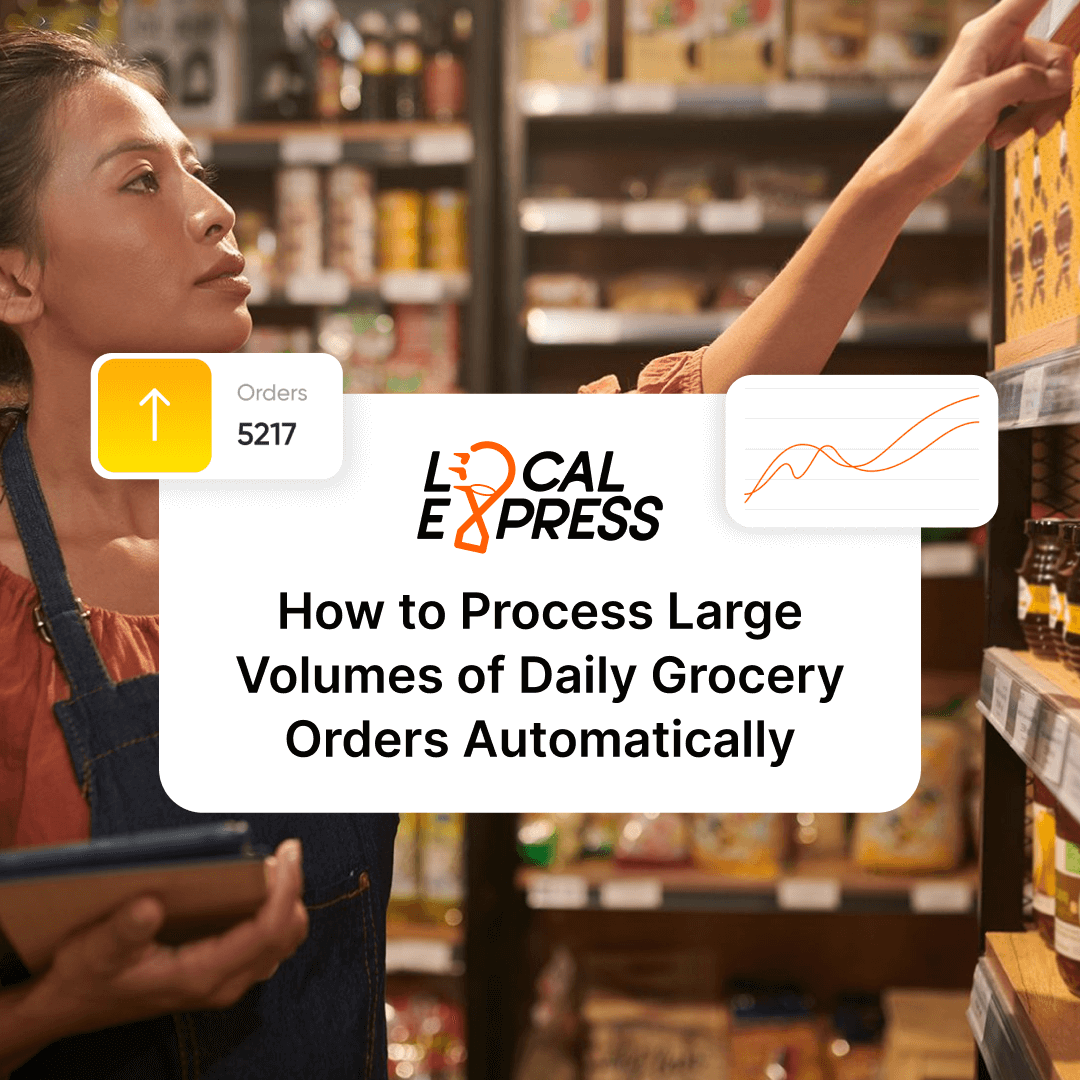


Order processing software forms the backbone of automated grocery fulfillment, orchestrating everything from order receipt through final delivery. These systems eliminate manual data entry, reduce errors, and enable real-time visibility across your entire operation.
Modern order management platforms integrate multiple components:
The transformation from manual to automated processing delivers measurable results. Research shows companies implementing automation see 10-15% cost reductions in the first year after implementation, with processing times improving from days to hours. When vendor-sponsored surveys indicate 52% of companies report significant demand increases from e-commerce, these efficiency gains become critical for survival.
Key integration requirements include compatibility with existing POS systems, support for real-time data exchange, and scalability to handle peak volumes. Leading platforms now offer one-click synchronization with major systems like NCR, Toshiba, and IT Retail, eliminating the technical barriers that previously hindered adoption.
Inventory management forms the foundation of successful order automation. Without accurate, real-time stock data, even the most sophisticated order processing systems fail. Modern inventory tracking solutions leverage predictive AI and seamless POS integration to maintain optimal stock levels while preventing the overselling that damages customer trust.
The cornerstone of automated inventory management is real-time synchronization across all channels. When a customer purchases the last unit of an item in-store, your online platform must instantly reflect that change. This prevents the nightmare scenario of accepting orders you cannot fulfill.
Essential components for real-time tracking include:
The impact is substantial: retailers implementing real-time tracking reduce waste from 4% to 2% while maintaining higher in-stock rates during peak demand periods.
AI-powered predictive analytics transform inventory management from reactive to proactive. These systems analyze historical sales patterns, seasonal trends, and external factors to forecast demand with remarkable accuracy.
Predictive systems deliver:
Labor is typically the largest single cost in grocery fulfillment operations. Automated inventory management directly impacts profitability by reducing manual counting and ordering tasks.
Same-day delivery has evolved from luxury service to customer expectation, with delivery sales growing 36% year-over-year to reach $4.3 billion in July 2024. Building scalable delivery infrastructure requires sophisticated delivery management systems that balance speed, cost, and capacity.
Modern delivery management platforms connect to multiple networks simultaneously, providing flexibility and redundancy. Integration with services like DoorDash, Uber, and specialized grocery couriers through a single API eliminates the complexity of managing multiple relationships.
Key considerations for partner selection:
Leading platforms now offer connections to 100+ delivery networks through unified interfaces, enabling instant scalability without infrastructure investment.
For retailers operating their own delivery fleets, automation streamlines dispatch, routing, and driver management. AI-powered routing algorithms optimize delivery sequences, reducing mileage and improving efficiency.
Fleet management automation includes:
The financial impact is significant: optimized routing and dispatch automation can cut last-mile costs by up to 30% according to platform providers, while maintaining or improving delivery speeds.
Enterprise-scale operations like Walmart process millions of orders weekly, requiring robust infrastructure and sophisticated automation. Understanding their approach provides valuable insights for scaling your own operations.
Large retailers leverage micro-fulfillment centers (MFCs) that, according to McKinsey, achieve up to 5x manual picking speeds in spaces as small as 10,000-15,000 square feet. These facilities combine automated storage systems with robotic picking to handle massive volumes efficiently.
Enterprise automation strategies include:
While MFCs require $8-10 million investments depending on vendor, scale, and integration level, they enable processing of thousands of orders daily with minimal labor.
Managing inventory and fulfillment across multiple locations requires sophisticated orchestration. Modern marketplace integration platforms enable centralized control while maintaining store-level flexibility.
Critical capabilities for multi-location operations:
The Asia Pacific region's 61.5% share of global online grocery revenue demonstrates the importance of scalable, multi-location infrastructure.
Third-party platforms like Instacart have become essential channels, but integration complexity often creates operational challenges. Successful integration requires sophisticated data harmonization and workflow optimization.
Marketplace platforms each have unique requirements for product data, inventory updates, and order processing. Manual management across multiple platforms becomes impossible at scale.
Automated integration solutions provide:
Advanced platforms can deploy catalogs across marketplaces in 5-14 days, dramatically accelerating channel expansion.
Whether using Instacart shoppers or your own staff, performance monitoring and optimization are crucial. AI-powered systems track key metrics and identify improvement opportunities.
Performance management tools include:
Technology augmentation becomes essential for maintaining quality standards and improving overall accuracy rates in manual picking operations.
Successful automation requires thoughtful workflow design and staff enablement. Technology amplifies human capabilities rather than replacing workers entirely.
Transitioning to automated systems requires comprehensive training programs. Modern platforms simplify this with intuitive interfaces and built-in guidance.
Training priorities include:
Leading systems require only 2-4 hours of training for basic proficiency, minimizing productivity disruption during implementation.
Automated workflows must align with physical store layouts and operational constraints. AI-powered systems learn optimal paths and continuously improve efficiency.
Workflow design considerations:
Research shows 50% faster order processing when workflows are properly optimized for automation, directly impacting customer satisfaction and operational costs.
Practical examples demonstrate automation's transformative impact across different retail formats and scales.
Independent retailers often see the most dramatic improvements from automation. A California specialty grocer implemented automated order processing and achieved:
These results prove that automation isn't just for large chains—smaller retailers can achieve proportionally greater benefits.
Large chains demonstrate automation's scalability. One eight-location Midwest chain reported:
The global automation market reaching $11.91 billion by 2034 indicates widespread adoption across all retail segments.
AI-powered store mapping revolutionizes in-store fulfillment, transforming chaotic manual picking into precise, efficient operations.
Artificial intelligence analyzes store layouts, product locations, and order patterns to generate optimal picking routes. The system continuously learns and adapts as stores reorganize or introduce new products.
AI optimization delivers:
These improvements enable fulfilling multiple orders in one go, achieving the 50% speed improvement that makes same-day delivery economically viable.
Processing multiple orders simultaneously multiplies efficiency gains. Advanced systems intelligently group orders sharing similar items or zones.
Multi-order capabilities include:
With proper implementation, stores can process 30,000 orders weekly according to McKinsey research, using the same staff that previously handled a fraction of that volume.
Seamless POS integration eliminates data silos and ensures consistency across all channels. Modern grocery ecommerce platforms offer one-click synchronization with major POS systems.
Leading platforms support integration with:
Integration eliminates manual data entry, reducing errors and ensuring price consistency across channels.
Real-time synchronization maintains accuracy across systems:
Proper synchronization prevents the price inconsistencies that erode customer trust and create operational headaches.
Modern customers expect flexibility in how they receive orders. Successful retailers offer multiple fulfillment options through unified omnichannel solutions.
Managing multiple fulfillment channels requires sophisticated orchestration:
Each channel requires specific workflows, but unified platforms manage all from a single dashboard.
Automated communication keeps customers informed throughout the fulfillment process:
Clear communication reduces support inquiries and improves satisfaction scores.
While numerous platforms promise automation, LocalExpress delivers comprehensive solutions specifically designed for food retailers seeking to process high volumes efficiently without sacrificing their brand identity.
LocalExpress's AI-powered unified platform uniquely combines:
Unlike generic e-commerce platforms, LocalExpress understands the unique challenges of grocery retail—from managing weighted items to handling perishables. The platform's AI Grocery Data Fusion module automatically harmonizes product data from multiple sources, accelerating store onboarding and maintaining real-time accuracy.
For grocers serious about automation, LocalExpress provides white-glove implementation with deployment timelines varying by scope and complexity. The platform scales from single independent stores to multi-location chains, maintaining brand identity while delivering enterprise-grade capabilities. Explore their prepared food solutions for deli automation or discover how retail media integration can generate additional revenue streams.
Implementation typically takes 3-6 weeks for pilot programs and 12-18 months for full deployment, depending on scale and complexity. The process includes initial assessment and planning (1-2 weeks), system configuration and POS integration (2-3 weeks), staff training (3-5 days), and optimization based on real-world performance (ongoing). Some platforms like LocalExpress report that retailers can go live in weeks due to pre-built integrations, though actual timelines vary by scope.
Yes, modern order processing platforms integrate seamlessly with major POS systems including NCR, Toshiba, IT Retail, Square, and many others through standardized APIs or custom connectors. Integration typically involves webhook setup for real-time data exchange, initial catalog synchronization, and ongoing monitoring to ensure data consistency. Leading platforms offer one-click integration that eliminates technical complexity.
Automated systems scale dramatically based on configuration. Small implementations handle 150-500 orders daily, while enterprise deployments process 30,000+ orders weekly. According to McKinsey, micro-fulfillment centers achieve 600-800 units per hour processing rates, compared to 60-70 units manually. The key is matching automation level to your volume—starting with enhanced picking systems and scaling to full automation as demand grows.
Cost reductions vary by implementation scope but typically range from 10-15% for basic automation in the first year. Labor cost reductions average 25% while maintaining or improving service levels. Additional savings come from reduced errors, decreased waste through better inventory management, and improved customer retention from consistent service quality.
Yes, modern delivery management platforms connect to 100+ delivery networks through unified APIs, enabling seamless switching between providers based on availability, cost, and performance. This includes major services like DoorDash and Uber, regional providers, and in-house fleets. Unified platforms handle dispatch, tracking, and reconciliation across all networks from a single interface.

